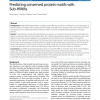294 search results - page 23 / 59 » Predicting the beta-helix fold from protein sequence data |
BMCBI
2006
13 years 7 months ago
2006
Background: When accurate models for the divergent evolution of protein sequences are integrated with complementary biological information, such as folded protein structures, anal...
BMCBI
2010
13 years 2 months ago
2010
Background: Profile HMMs (hidden Markov models) provide effective methods for modeling the conserved regions of protein families. A limitation of the resulting domain models is th...
BICOB
2010
Springer
13 years 5 months ago
2010
Springer
Fold recognition is a key problem in computational biology that involves classifying protein sharing structural similarities into classes commonly known as "folds". Rece...
NAR
2007
13 years 7 months ago
2007
Understanding interactions between proteins and RNA is key to deciphering the mechanisms of many important biological processes. Here we describe RNABindR, a web-based server that...
BMCBI
2010
13 years 7 months ago
2010
Background: Type III secretion system (T3SS) is a specialized protein delivery system in gramnegative bacteria that injects proteins (called effectors) directly into the eukaryoti...

